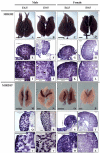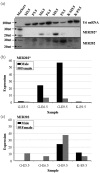Sexually dimorphic microRNA expression during chicken embryonic gonadal development
- PMID: 19357368
- PMCID: PMC3093991
- DOI: 10.1095/biolreprod.108.074005
Sexually dimorphic microRNA expression during chicken embryonic gonadal development
Abstract
MicroRNAs are a highly conserved class of small RNAs that function in a sequence-specific manner to posttranscriptionally regulate gene expression. Tissue-specific miRNA expression studies have discovered numerous functions for miRNAs in various aspects of embryogenesis, but a role for miRNAs in gonadal development and sex differentiation has not yet been reported. Using the chicken embryo as a model, microarrays were used to profile the expression of chicken miRNAs prior to, during, and after the time of gonadal sex differentiation (Embryonic Day 5.5 [E5.5], E6.5, and E9.5). Sexually dimorphic miRNAs were identified, and the expression patterns of several were subjected to further validation by in situ hybridization and Northern blot analysis. Expression of one chicken miRNA, MIR202*, was observed to be sexually dimorphic, with upregulation in the developing testis from the onset of sexual differentiation. Additional data from deep sequencing of male and female embryonic gonad RNA samples also indicated upregulation of MIR202* in male gonads. These findings provide the first evidence of sexually dimorphic miRNA expression during vertebrate gonadal sex differentiation and suggest that MIR202* may function in regulating testicular development.
Figures






References
Publication types
MeSH terms
Substances
Associated data
- Actions
LinkOut - more resources
Full Text Sources
Molecular Biology Databases

